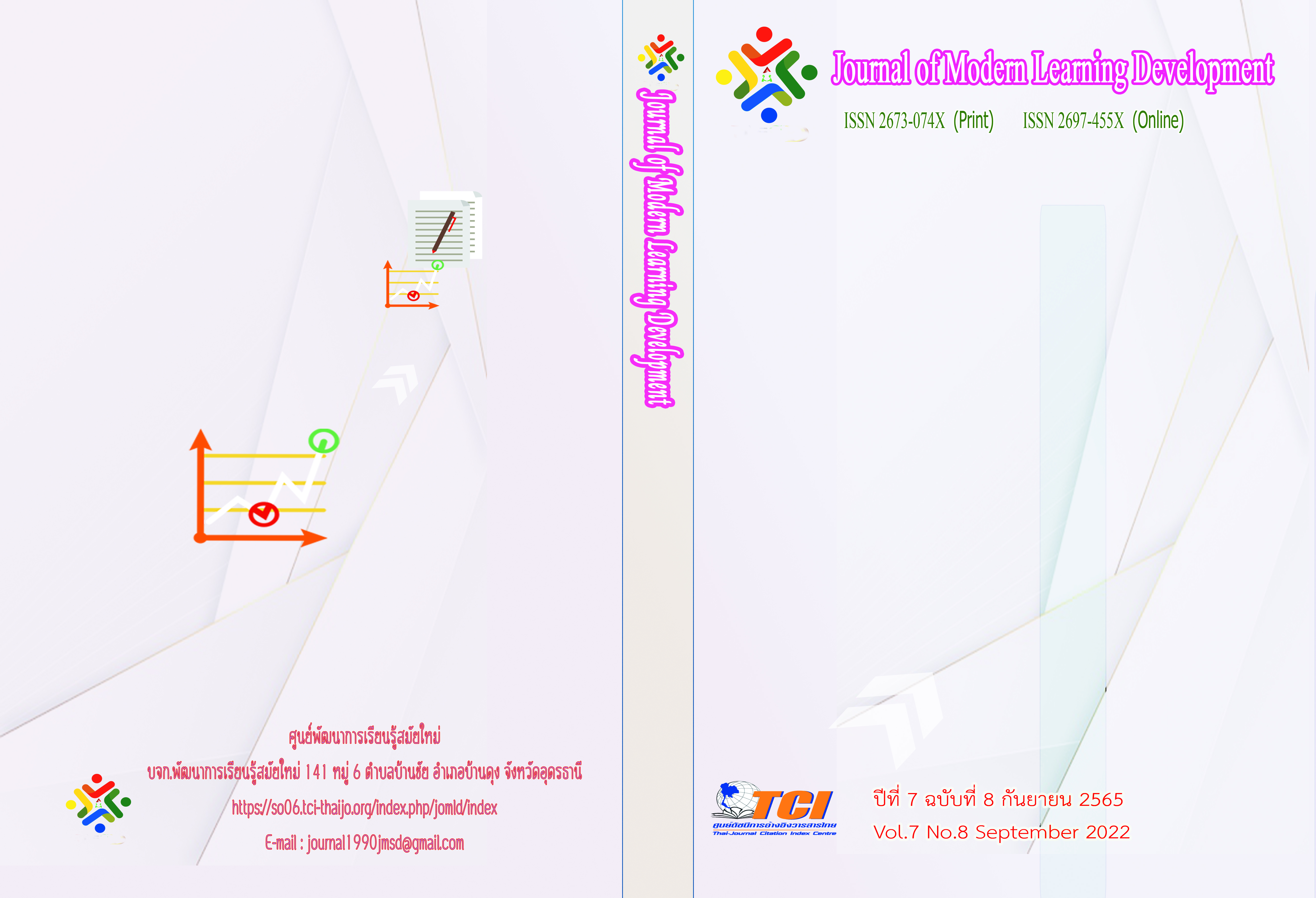An effective capacity building system for learners with intellectual disabilities. Sukhothai Provincial Special Education Center
Main Article Content
Abstract
The objectives of this research were: 1) Develop an effective capacity building system for learners with intellectual disabilities. Sukhothai Provincial Special Education Center. 2) evaluate the effectiveness the promotion syste effective potential For learners with intellectual disabilities Sukhothai Provincial Special Education Center developed to use. These papers are research and development. The research informants were 9 experts for system evaluation and experimental group using the system include 10 teacher and personnel and 10 parent.Purposive selected samples. The instruments which were used in this research are 1.suitability assessment form possibility helpfulness and the suitability of the user manual.
2) Cognitive Quiz. 3) System Evaluation Form. 4) satisfaction assessment form and 5) System Effectiveness Assessment Form. The statistics used in the study were percentage, mean, and standard deviation.present data with tables caption diagram.
A result of this study was found in the following aspects.
1) An effective capacity building system for students with intellectual disabilities Sukhothai Provincial Special Education Center, consisted of 4 Input factors including (1) man (2) money (3) management and (4) material, Process factors consisted of 7 factors including (1) Teamwork (2) Training (3) Tools (4) Teaching Technique (5) Teaching methods (6) Testing and (7)Transitions. Output factors consisted of 2 factors including. (1) Those involved have knowledge and understanding about the potential enhancement of learners with intellectual disabilities, (2) Stakeholders have confidence that learners with intellectual disabilities can develop. Outcome factors consisted of 3 factors including. (1) Those involved can organize activities to promote the potential of learners with intellectual disabilities. (2) Learners who have Intellectual disabilities are empowered As stated in individual education plans or family-specific assistance plans based on individual potential. (3) Learners have desirable characteristics of the educational establishment. And 5) The feedback consisted of 2 factors including. (1) Reporting results, problems, and obstacles. (2) The use of the assessment results to improve and rectify according to the recommendations. The results of the system evaluation by experts found that the suitability was at the highest level, the feasibility assessment was at the highest level, the usefulness assessment was at the highest level.
2) Assessment results effective capacity building system For learners with intellectual disabilities Sukhothai Provincial Special Education Center. It was found that teachers, staff, and parents had higher scores on the cognitive test and passed the criteria of 80 percent. The results of the development of potential and desirable characteristics of all learners with intellectual disabilities were higher. The ability to implement the system is at the highest level. Satisfaction affecting the overall system at the highest level. and the results of the system effectiveness assessment were overall appropriate at the highest level.
Article Details
References
กรวิภา งามวุฒิวงศ์. (2559). ปัจจัยที่ส่งผลต่อการทางานเป็นทีมภายในสำนักอำนวยการสำนักงานปลัดกระทรวงศึกษาธิการ. การค้นคว้าอิสระหลักสูตรรัฐศาสตรมหาบัณฑิต (บริหารรัฐกิจและกิจการสาธารณะ) สาขาวิชาบริหารรัฐกิจและกิจการสาธารณะ สำหรับนักบริหารคณะรัฐศาสตร์. บัณฑิตวิทยาลัย: มหาวิทยาลัยธรรมศาสตร์.
แก้วตา นพมณีจำรัสเลิศและคณะ. (2558). การส่งเสริมเด็กพัฒนาการล่าช้าเด็กพิเศษอย่างเป็นองค์รวมฉบับ
ความสุข. สถาบันแห่งชาติเพื่อพัฒนาเด็กและครอบครัว.กรุงเทพมหานคร: มหาวิทยาลัยมหิดล.
นภดล ธุลีจันทร์. (2550). การพัฒนารูปแบบการช่วยเหลือระยะแรกเริ่มเด็กพิการโดยการบริหารจัดการแบบมีส่วนร่วมของศูนย์การศึกษาพิเศษ ประจำจังหวัดเลย.สำนักบริหารงานการศึกษาพิเศษ. กระทรวงศึกษาธิการ. กรุงเทพมหานคร.
ประจักร ทานาม. (2559). การพัฒนาทักษะทางสังคมของเด็กที่มีความบกพร่องทางด้านสติปัญญาด้วยกิจกรรมการแข่งขัน. ภาควิชาการศึกษาพิเศษ คณะครุศาสตร. มหาสารคาม: มหาวิทยาลัยราชภัฎมหาสารคาม.
พรพรรณ์ สมบูรณ์. (2552). รูปแบบการบริการการเปลี่ยนผ่านจากโรงเรียนเรียนร่วมสู่การทำงานของนักเรียน
พิการระดับมัธยมศึกษา. วิทยานิพนธ์ปริญญาเอก หลักสูตรปริญญาปรัชญาดุษฏีบัณฑิต. บัณฑิตวิทยาลัย: มหาวิทยาลัยศิลปากร.
พรรณพร ศรีสังข์. (2555). การพัฒนาทักษะภาษาของนักเรียนที่มีภาวะบกพร่องทางสติปัญญาระดับเล็กน้อยโดยใช้วิธีการสอนภาษาแบบองค์รวม. วิทยานิพนธ์ กศ.ม. (หลักสูตรและการสอนการศึกษาพิเศษ) .บัณฑิตวิทยาลัย: มหาวิทยาลัยขอนแก่น.
มาศพร แกล้วทะนง. (2551). การสอนทักษะการชวยเหลือตนเองสําหรับนักเรียนที่บกพรองทางสติปญญาระดับรุนแรง โดยการวิเคราะหงานรวมกับการใชภาพประกอบ. วิทยานิพนธปริญญาการศึกษามหาบัณฑิต (การศึกษาพิเศษ). บัณฑิตวิทยาลัย: มหาวิทยาลัยศรีนครินทรวิโรฒ.
ราชกิจจานุเบกษา. (2552). ประกาศกระทรวงศึกษาธิการ เรื่อง กำหนดประเภทและหลักเกณฑ์ของคนพิการ
เพื่อการศึกษา พ.ศ. 2552.ในราชกิจจานุ เบกษา เล่มที่ 126 ตอนพิเศษ 80 ง.
วรัฒม์ ศรีเทพ. (2551). การศึกษาความพึงพอใจของผู้ปกครองต่อการจัดการศึกษาพิเศษของโรงเรียนสุพรรณบุรีปัญญานุกูล. วิทยานิพนธ์ กศ.ม. บัณฑิตวิทยาลัย: มหาวิทยาลัยเกษตรศาสตร์.
วิชัย วงษ์ใหญ่ และ มารุต พัฒผล .(2564). พหุปัญญาในชั้นเรียน. บัณฑิตวิทยาลัย:มหาวิทยาลัยศรีนครินทรวิโรฒ.
สัตติยา ชวยหนู. (2551). การพัฒนาทักษะการชวยเหลือตนเองของเด็กที่มีความบกพรองทางสติปญญาโดยใชวิธีการวิเคราะห์งานร่วมกับวิธีลูกโซยอนกลับ. วิทยานิพนธ์ กศ.ม. บัณฑิตวิทยาลัย: มหาวิทยาลัยศรีนครินทรวิโรฒ.
สุจิตรพร สีฝั้น. (2550). การพัฒนาแบบการให้บริการในระยะเชื่อมต่อเฉพาะบุคคลสำหรับเด็กที่มีความต้องการพิเศษจากระบบการให้บริการช่วยเหลือระยะแรกเริ่มเข้าสู่ระบบโรงเรียน. วิทยานิพนธ์ปริญญาดุษฎีบัณฑิต สาขาวิชาการศึกษาพิเศษ. บัณฑิตวิทยาลัย: มหาวิทยาลัยศรีนครินทรวิโรฒ.
สุวรรณ บัวพันธ์. (2564). การพัฒนารูปแบบการส่งเสริมศักยภาพเด็กที่มีความบกพร่องทางสติปัญญาโดยใช้กิจกรรมตามแนวคิดวอลดอร์ฟของศูนย์การศึกษาพิเศษประจำจังหวัดกาฬสินธุ์. รายงานการวิจัยผลงานระดับผู้อำนวยการเชี่ยวชาญ. สำนักบริหารงานการศึกษาพิเศษ.
สุวรรณา มีวัฒนะ. (2554). การศึกษาความสามารถในการปฏิบัติอย่างอิสระตามกระบวนการการจัดกิจกรรม
เด็กปฐมวัยที่มีความบกพร่องทางสติปัญญา ระดับเล็กน้อยใช้ตารางกิจกรรมที่มีภาพประกอบร่วมกับเบี้ยอรรถกร. วิทยานิพนธ์ กศ.ม. (สาขาการศึกษาพิเศษ). บัณฑิตวิทยาลัย: มหาวิทยาลัยศรีนครินทรวิโรฒ.
สำนักงานเลขาธิการสภาการศึกษา. (2563). AI เพื่อพัฒนาการเรียนรู้ . (หนังสืออิเล็กทรอนิกส์). กรุงเทพมหานคร: สำนักมาตรฐานการศึกษาและพัฒนาการเรียนรู้ สำนักงานเลขาธิการสภาการศึกษา.
Alana S. Hillman. (2013). Early Intervention and Student Achievement. A Dissertation submitted to the Education Faculty of Lindenwood University in partial fulfillment of the requirement for the degree Doctor of Education.
Alper, S.et al .(1994). Families of Student with Disabilities : Consultation and Advocacy. Boston.Allyn and Bacon.
Kohler, P. D. (1996). Taxonomy for Transition Programming : Linking Ressearch to Practice. Champaign :Transition Research Institute, University of Illinois.
Maskay Bishwa K. (2001). Equalization of Opportunities for The Mentally Retarded.n.p. : Modern Printing Press.
Mary Jo Noonan, Linda Mc Cormick. (1993). Early Intervention in Natural Environments:
Methods and Procedures – Research Gate.
O’Tool, B., and R. McConkey. (1995). Innoveations In Developing Countries for People with
Disabilities. Lisicuix Hall Publications.
Pierangelo, Roger. (2003). The Special Educator’s Book of Lists. (2nd ed). John Wiley & Sons
,San Francisco : Jossey – Bass Publications.
U.S. Department of Treasury. (2006). Early intervention 2005-2006 budget paper No.3. New York. USA.


